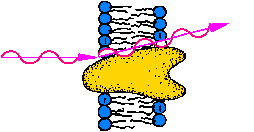 |
Membrane Pharmacy Structure DynamicsResearch group : Priv.Doz. Dr. Thomas NawrothEvolution |
 |
Membrane Pharmacy Structure DynamicsResearch group : Priv.Doz. Dr. Thomas NawrothEvolution |
Topics : Origin of live , molecular evolution of proteins and exobiology
The evolution of live at the early earth about 4,000,000,000 years ago,
has obviously been an evolution of chemical molecules initially. While
a parallel evolution at several levels, proteins, nucleic acids and carbohydrates
is possible, a molecular evolution of amino acids and proteins as the first
step is mostly probable. The reason for this assumption is the easy and
fast formation of amino acids from simple compounds, which have been present
at the early earth, the speed of polypeptide (primitive protein) formation
and hydrolysis from these compounds and the capability of information generation
and storage in the sequence of the components in these "proteins". Up to
this point it does not matter, if live has formed at earth itself, or if
it was imported by an impact of a metoerite from another planet, which
could be the location of the origin of live.
The small but significant chance of the latter case is described by the
panspermy theory of exobiology, which has a relevance
also for a possible export of live from earth to other planets. Nevertheless
the speed of protein formation in a amino acid solution under favorite
conditions, and the selectivity of the information generation reactions
offer the formation of live on earth itself as the most probable possibility.
Thus a chemical evolution may happen also at other locations in space,
if the chemical composition of the planet and the temperature range are
fortunate, and if the reaction conditons are stable for a sufficient time.
The chemical evolution at the origin of our live, probably at earth,
led from a complex atmosphere containing nitrogen, hydrogen, methane and
ammonia and water to evolving complex solutions of larger molecules due
to Miller et al. Probably these had a carbon backbone and several amino
and oxygen containing sidechains. The most important feature of these compounds,
amino acids, amino-carbohydrates, amino-alcohols etc., is the capability
of the formation of larger molecules by polycondensation and polymerization.
This led to macromolecules bearing catalytic properties and storing information
in their chemical composition (a primitive sequence). By repeptitive cycles
of synthesis and destruction (hydroysis) a probably system of self-instruction
and auto-catalysis established. This is possible with proteins from amino
acids and, more complicated, with nucleiuc from amino-compounds and carbohydrates.
Due to laboratory experiments the formation of catalytic primitive proteins
is faster, but the information storage is favored at the nucleic acid level.
The specific reaction conditions are unknown. Thus the precise origin of
live cannot be resolved. Nevertheless some possiblities how some components
and systems can be generated can be established by laboratory experiments
on chemical evolution. A review on the probable early stages of live
is given by Prof. K. Dose in his book "Chemical evolution and the origin
of live" (Elsevier) and several reviews, e.g in [Chemie in unserer Zeit
21, 177-185 (1987)]. The later stages of evolution have been described
by Prof. M. Eigen, who has got the Nobel award for his investigations,
which showed especially the superior properties of a combination
of protein and nucleic acid live systems by mathematical theory.
....